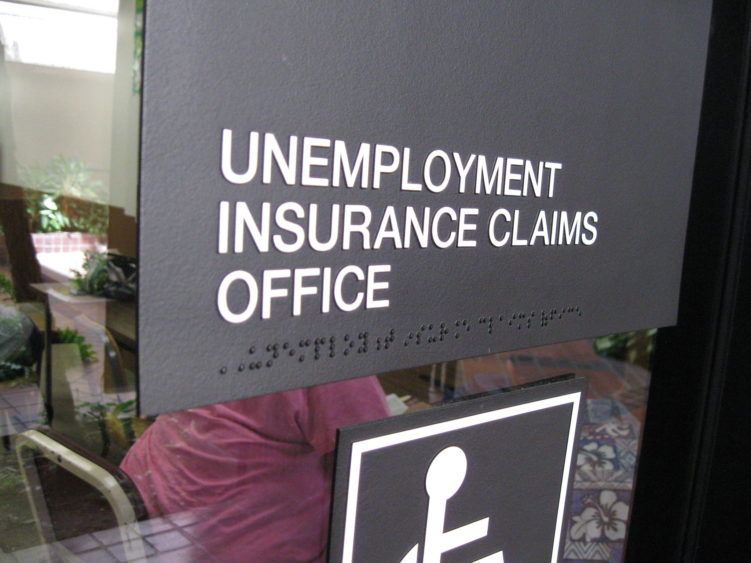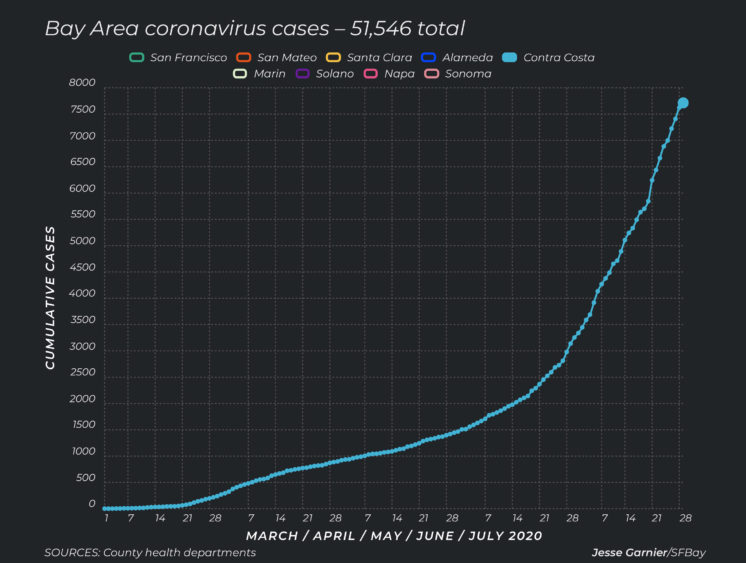There’s not much insulated from the impact of Covid-19 at this point, be it in the world of sports or in the economic realm.
Here, we’ll get into some of the bigger stories from around country and state, and we dig into the details from each of the nine Bay Area counties, all of which are now on the state’s monitoring list.
U.S.
- Confirmed Cases: 4,424,806
- Deaths: 150,676
Source: John Hopkins University Coronavirus Resource Center COVID-19 global tracking tool as of Wednesday at 6:35 p.m.
The return of professional U.S. sports may be a short-lived adventure. Just four days after Major League Baseball launched their 2020 season with traveling games, news broke Monday that a Covid-19 outbreak struck the Miami Marlins after playing a series against the Philadelphia Phillies. According to a statement issued by Marlins CEO Derek Jeter, a home opener game against the Baltimore Orioles scheduled for Monday night was postponed while additional testing is conducted — it was later decided that all Marlins games would be suspended until at least Sunday. The Athletic reported Tuesday that at least 17 people associated with the team have tested positive in recent days.
Unlike the NBA, which chose to play bubble-style games in one location, the MLB’s plan to allow team travel between states is backfiring. The outbreak is causing alarm among other professional sports as well — several NFL players have recently opted out of the 2020 season.
Open SFBay USA coronavirus tracker.Sen. Majority Leader Mitch McConnell unveiled the GOP’s $1 trillion stimulus bill, dubbed the HEALS Act, or formally the Health, Economic, Assistance, Liability protection and Schools Act. The differences between the HEALS Act and the HEROES Act that House Democrats passed in May are vast, namely in the $2 trillion gap that leaves unemployed people and states without desperately needed resources.
Although the bill includes another one-time $1,200 direct payment, it reduces the weekly pandemic unemployment assistance, made possible by the CARES Act, from $600 to $200 weekly. For independent contractors receiving unemployment insurance benefits for the first time, the default base rate is currently $167 per week. With the reduction of the additional weekly PUA, that means independent contractors and freelancers could be left with no more than $367 per week. In the Bay Area, where rent is commonly in the $3,000 range, the hit to unemployment benefits is especially rough.

The Republican bill also excludes an extension for the federal eviction moratorium, which expired Friday.
The GOP stimulus focuses on efforts to get people back to work, students back into schools and protect business owners from liabilities if Covid-19 outbreaks occur. The schools funds are also packed with controversy — the HEALS Act bill would reserve two-thirds of the $70 billion K-12 allocation for schools that reopen for in-person instruction. Schools in areas with high infection rates are largely mandated to begin the year online and transition to in-person instruction once deemed safe — the funding issue pressures districts to weigh the health and safety of students and staff against a desperate need for financial help.
California
- Confirmed Cases: 483,806
- Deaths: 8,883
Source: John Hopkins University Coronavirus Resource Center COVID-19 global tracking tool as of Wednesday at 6:35 p.m.
The Democrat-led California Legislature is planning around anticipated shortcomings of the federal HEALS Act bill. In a $100 billion proposal introduced Monday, the state is looking at creative financing with a “future tax vouchers” system, accelerated general fund spending and federal borrowing. In part, the bill aims to make up for the federal PUA benefit loss, bolster small businesses and incentivize local manufacturing of personal protective equipment.
Gov. Gavin Newsom is getting tough on cities that defy state health orders. Atwater in Merced County and Coalinga in Fresno County were both warned that by allowing all businesses to open during the pandemic, they risked the state withholding a combined $100,000 in federal funds. Councilmembers in both cities met Monday and voted to continue as they have been, in defiance. Despite Newsom’s announcement Monday that he would invest $52 million to bolster testing and resources for impacted residents in the Central Valley, Atwater Mayor Paul Creighton accuses the governor of abandoning the city.
California Health and Human Services Secretary Dr. Mark Ghaly said Tuesday that the Central Valley is failing to slow the rate of Covid-19 hospitalizations and bend the case curve.
Santa Cruz County is now on the County Monitoring List radar after three consecutive days, joining most of the greater Bay Area, with the exception of San Mateo County, though that exemption could soon be over. According to the California Department of Public Health, Tuesday’s data reflects that Santa Cruz County is recording 123 positive cases per 100,000 people — the goal is to remain below 100 cases per 100,000 residents.

Alameda County
- Confirmed Cases: 10,733
- Deaths: 181
Source: Alameda County Public Health Department as of Wednesday with data reported through Tuesday.
After three days of seeming decline, the overall hospitalization rate is back up nearly to peak levels with 198 Covid-19 patients reported Monday. The highest level seen since the pandemic took hold was Thursday with 201 patients. The number of coronavirus patients in ICU beds has hit a new high of 65.
The cumulative case total in Oakland has risen to 4,287 — Hayward is reporting 1,551 cases as of Sunday night.
The Alameda County Sheriff’s Office last reported Tuesday that 22 inmates at Santa Rita Jail have active Covid-19 infections, three of whom are showing symptoms. A total of 196 inmates have tested positive to date — 20 of which were released from custody. Additionally, there are 11 active cases among staff members and contractors — 50 staff or contractors have tested positive cumulatively. Sheriff’s Office officials said late Tuesday via Twitter that none of the staff assigned to Santa Rita Jail have died. However, one Alameda County sheriff’s deputy and one staff member died last week.
Contra Costa County
- Confirmed Cases: 7,304
- Deaths: 108
Source: Contra Costa Health Services as of Tuesday at 11:30 a.m.
The county has made a substantial adjustment to its confirmed case total since Tuesday’s health department reporting. A total of 7,304 cases were recorded as of Tuesday at 11:30 a.m., but that number jumped by another 410 cases in comparison to Wednesday’s data. As we’ve seen in counties across the Bay Area, case counts tend to adjust for any given day within a limited timeframe — basically, data lags a bit for exact-day recording of positive test results. The spike we’re seeing now reflects that 398 positive test results were reported Monday, which makes for the largest one-day gain throughout the nine-county region.
The test positivity rate is now at 8.2 percent.
Richmond maintains the highest number of cases and the third highest concentration per 100,000 residents. Concord, with the county’s largest populated city, is reporting 851 cases per 100,000 residents and 302 new confirmed cases in the past 14 days. Bay Point, El Sobrante and Pittsburg are also experiencing high case rates per capita.

The Board of Supervisors unanimously approved an emergency ordinance that establishes, effective immediately, administrative fines for public health order violations. Basically, individuals found not wearing face coverings or social distancing in areas mandated, or gathering in large groups, can be issued a citation and fined $100 for the first violation, $200 for the second and $500 for each additional violation.
Commercial offenders will face $250 fines for a first offense, $500 for a second and $1,000 for each subsequent violation. The ordinance does allow for “educational enforcement” prior to fined citations, with notices provided to individuals and businesses that can be given up to two days to correct the action. The complete version of the ordinance can be accessed online.
Marin County*
- Confirmed Cases: 4,874
- Deaths: 64
Source: Marin Health and Human Services as of Wednesday. CDCR data as of Saturday afternoon.
*Marin County began reporting San Quentin State Prison cases separately, but for the purposes of tracking actual infections and potential impact on the county, we’ve included inmate cases with the county’s cumulative total. Staff member infections are detailed below but are included in county of residence totals.
Five people have died in Marin County since Monday — that statistic is outside of what’s being reported at San Quentin State Prison. The county’s isolated cumulative case count is at 2,706 with a 5.6 percent test positivity rate.

San Quentin State Prison
Of the inmates at the prison, 2,168 have tested positive to date and 19 have resulted in death. The California Department of Corrections and Rehabilitation report that of the San Quentin infections recorded, 383 are still active.
Napa County
- Confirmed Cases: 860
- Deaths: 8
Source: Department of Health and Human Services as of Wednesday.
County officials report that the number of cases have nearly doubled in the past 24 days. Fifteen Covid-19 patients are hospitalized, according to the last data made available.
San Francisco
- Confirmed Cases: 6,197
- Deaths: 57
Source: San Francisco Department of Public Health with data as of Sunday.
Data is lagging by three days in general, but hospitalization rates, last updated Monday, reflect an all-time high of 112 total Covid-19 patients in hospitals and a near-peak level of 36 patients receiving ICU treatment. The highest ICU rate was 38 patients back on April 4.
San Mateo County
- Confirmed Cases: 5,306
- Deaths: 118
Source: San Mateo County Health Department with data reported through Tuesday.
After a good run off the state’s County Monitoring List, San Mateo County joined the rest of the Bay Area with three consecutive as of Wednesday. Like all other counties in the region, San Mateo will now have to shut down all bars and indoor dining, shopping malls, gyms, beauty services and places of worship. The addition of San Mateo brings the total number of counties on the state watchlist to 38, representing about 93 percent of California’s total population.
Santa Clara County
- Confirmed Cases: 9,612
- Deaths: 187
Source: Santa Clara County Public Health Department as of Wednesday.
Health department data updated Wednesday indicates that 185 confirmed Covid-19 patients are currently hospitalized countywide, 53 of whom are receiving ICU treatment. Of those who have died as a result, more than 12 percent lacked underlying health conditions.
Solano County
- Confirmed Cases: 3,462
- Deaths: 37
Source: Solano Public Health as of Wednesday at 6 p.m.
The county’s test positivity rate is currently sitting at 6.5 percent on average over the past seven days. Fifty Covid-19 patients are currently hospitalized, though the specific breakdown of acute versus ICU bed data was not made available Wednesday, as was also the case with much of the county’s health department data.
Sonoma County
- Confirmed Cases: 2,662
- Deaths: 31
Source: County of Sonoma with data as of Tuesday at 9:30 p.m.
The case count increased by an additional 86 confirmed infections in the past 24 hours.

Global
- Confirmed Cases: 16,957,763
- Deaths: 665,486
Source: John Hopkins University Coronavirus Resource Center COVID-19 global tracking tool as of Wednesday at 6:35 p.m.
The Vietnamese government this week began evacuating about 80,000 people, mostly local tourists, from the city of Da Nang after three residents tested positive for Covid-19. Prior to the new infections, the country had gone more than 100 days without recording a locally-transmitted case. Officials said the evacuation process will take about four days to complete. After the first of the three recent cases was discovered, Vietnam’s Prime Minister Nguyen Xuan Phuc immediately demanded large-scale contact tracing and testing.
Open SFBay Worldwide coronavirus tracker.